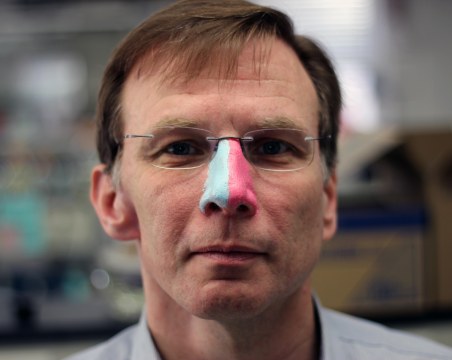As a child, I spent many summer days at the beach in southern California. I remember playing in the surf, collecting shells, watching sea lions, and seeing the white noses of the lifeguards. In those days, lifeguards smeared thick, white zinc oxide paste on their noses to protect themselves from getting sunburned

When my kids were young there was a brief period when colored zinc oxide sunblock seemed to be in vogue

Nowadays, we still use zinc oxide in sunblocks, but it’s no longer white or colored; it’s transparent! How can this be? It’s the same material!!

White pasty sunblocks protect your skin by absorbing and scattering away the harmful ultraviolet radiation. They also happen to scatter the less energetic form of radiation, visible light. They appear white in color because they scatter all colors of visible light roughly equally, so the white light that hits the sunblock is still white light when it hits our eyes. The colored sunblocks had pigments added that absorb some wavelengths of visible light.
Nano-enabled zinc oxide sunblock appears transparent because the smaller particles in it do not scatter light as effectively as their larger pasty counterparts. This might seem like a problem. If they don’t scatter light as effectively, wouldn’t that mean they would allow more harmful ultraviolet radiation through to your skin, unscattered? In fact, they do not! But I’m getting ahead of myself. First, let’s discuss why nano-sized zinc oxide particles are transparent while the larger sized particles in the older sunblocks appear white.
Different particle sizes scatter light to varying degrees.(1) As particles become so small that their diameters are equivalent to roughly half the wavelength of light, the intensity of scattered light falls steeply. This means, if you can make particles smaller than about half the wavelength of visible light (390 to 700 nanometers), they will no longer be able to scatter that visible light efficiently! So, nanoparticles smaller than roughly 200 nanometers are practically transparent.
Now that we’ve solved the problem of light scattering by zinc oxide particles in sunblock, let’s return to our earlier question. By making particles that don’t scatter visible light, have we created another problem? Aren’t we allowing harmful ultraviolet radiation to reach the skin on the lifeguards’ noses since we’re not scattering it away. Fortunately not! Nano-scale zinc oxide remains effective in sunblock because it efficiently absorbs ultraviolet light, preventing it from interacting with the skin.
Light scattering also depends on wavelength. For particles much smaller than the wavelength of light, those particles scatter shorter wavelength light (for example UV light) much more efficiently than longer wavelength light (for example, visible light). More precisely, for particles in this size range, scattering is inversely proportional to the fourth power of the wavelength. This means that UV light at, say, 350 nanometers is scattered nearly 5× more efficiently than green light at 520 nanometers, all else being equal. (The wavelength-dependent scattering is the reason the sky is blue, but I digress.)
In conclusion, we have seen that for scattering light, size matters! Zinc oxide nanoparticles can be made in sizes smaller that approximately 200 nanometers, so we no longer have to smear unsightly white paste on our noses to take advantage of the sun-protective effect of zinc oxide.
(1) For narrative convenience, I’ve assumed spherical zinc oxide nanoparticles. A group of researchers at Rice University examined the size and shape of zinc oxide nanoparticles in several commercial sunscreens and found them to be rod-shaped with one axis less than 40 nm and the other between 10 and 250 nm (Lewicka et al. Journal of Nanoparticle Research 2011).
For further reading:

[…] this year recognized as ScienceSeeker Editor’s Picks: Joel Pederson’s post, “Not Your Daddy’s Sunblock – Why Thick, White Sunblock is a Thing of the Past,” was selected for the week of Sept 28-Oct 4; Sunipa Pramanik’s post, “Using […]